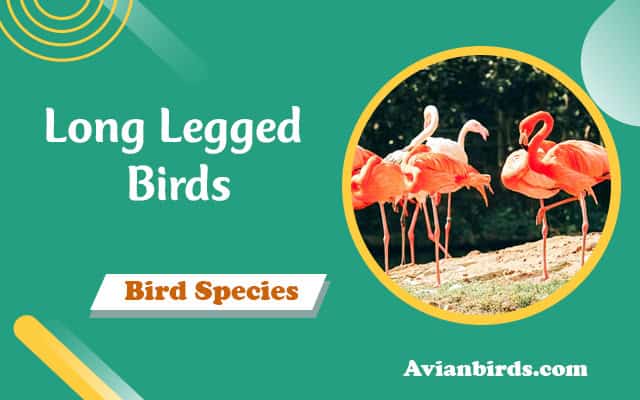30 Long Legged Birds: Identification Guide With Pictures
Birds with long legs exhibit unique adaptations for diverse habitats and lifestyles. From wetlands to savannas, these long-legged birds showcase fascinating appearances and behaviours. This guide helps identify 30 iconic long-legged birds, highlighting their traits, habitats, and key features.
Long Legged Birds
1. Great Blue Heron
The Great Blue Heron (Ardea herodias) is a prominent North American wading bird, notable for its tall stature, grey-blue plumage, and dagger-like bill. Often seen in wetlands and coastal regions, it exhibits a patient, stealthy hunting style, preying primarily on fish and small mammals. Standing about 4 feet tall with a wingspan of up to 6 feet, it’s an impressive sight when hunting or in flight.
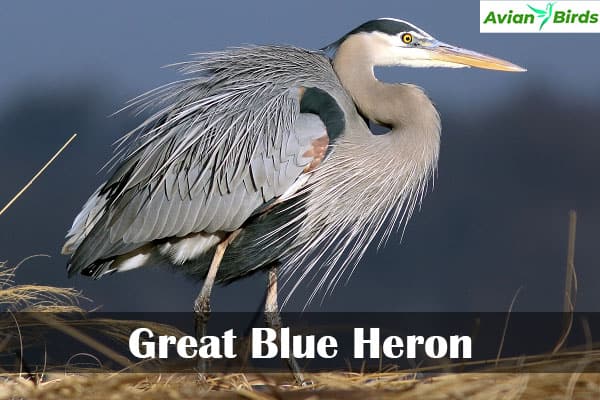
| Attribute | Description |
|---|---|
| Scientific Name | Ardea herodias |
| Habitat | Wetlands, coastal areas |
| Diet | Fish, amphibians, small mammals |
| Size | Up to 4 feet tall, 6-foot wingspan |
| Behavior | Patient hunting, slow and stealthy |
2. American Flamingo
The American Flamingo (Phoenicopterus ruber) captivates with its bright pink plumage, long legs, and unique, down-curved bill. Found in shallow waters and estuaries across the Caribbean, it feeds by filtering small invertebrates and algae, deriving its iconic color from pigments in its diet. Known for standing on one leg, these social birds are typically seen in flocks.
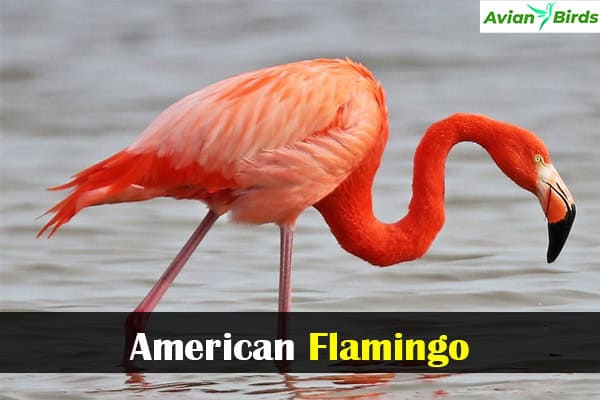
| Attribute | Description |
|---|---|
| Scientific Name | Phoenicopterus ruber |
| Habitat | Shallow waters, estuaries |
| Diet | Algae, small invertebrates |
| Size | Around 4-5 feet tall |
| Behavior | Filter-feeding, often stands on one leg |
3. Black Stork
The Black Stork (Ciconia nigra) is a striking bird with a glossy black body, white underparts, and slender red legs. Found across Europe and Asia, these storks prefer forested wetlands and migrate seasonally. Known for their shy and solitary behavior, they nest high in trees away from human settlements. Their graceful flight and rare appearances make them a special sight for birdwatchers.
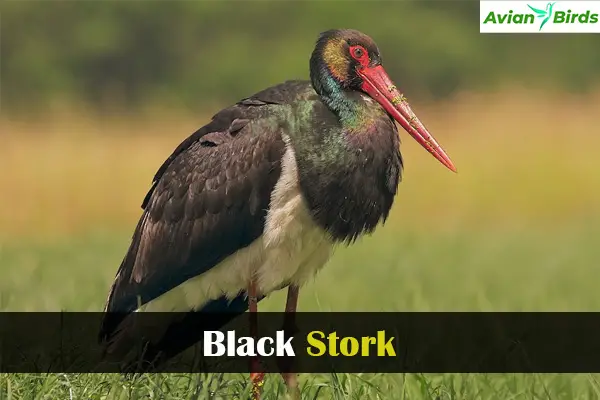
| Attribute | Description |
|---|---|
| Scientific Name | Ciconia nigra |
| Habitat | Forested wetlands, riverside forests |
| Diet | Fish, amphibians, insects |
| Size | About 3 feet tall, 6-foot wingspan |
| Behavior | Solitary, migratory, nests in high trees |
4. Sandhill Crane
The Sandhill Crane (Antigone canadensis) is known for its graceful appearance and distinctive red crown. These cranes are found across North America and parts of Siberia, inhabiting grasslands, marshes, and wetlands. With their trumpeting calls and synchronized movements, they perform intricate courtship dances. Standing up to 4 feet tall, they’re social birds often seen in large migratory flocks.
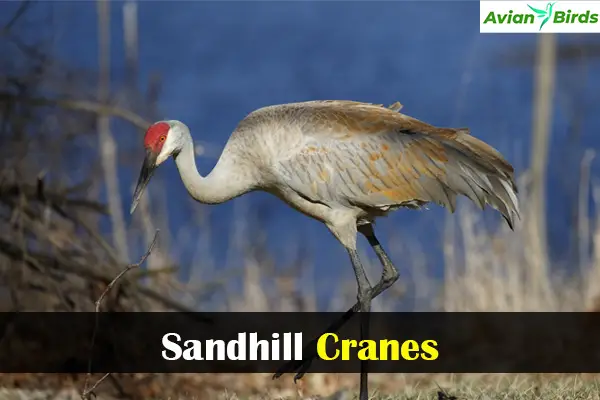
| Attribute | Description |
|---|---|
| Scientific Name | Antigone canadensis |
| Habitat | Grasslands, wetlands |
| Diet | Seeds, grains, insects, small mammals |
| Size | Up to 4 feet tall |
| Behavior | Social, migratory, elaborate courtship dances |
5. Wood Stork
The Wood Stork (Mycteria americana) is notable for its white body, bald black head, and long, curved bill. Native to North American wetlands, this stork feeds by feel, sweeping its open beak through shallow water to catch fish. Known for their unique feeding style and resilience, Wood Storks are an important indicator species for wetland health.
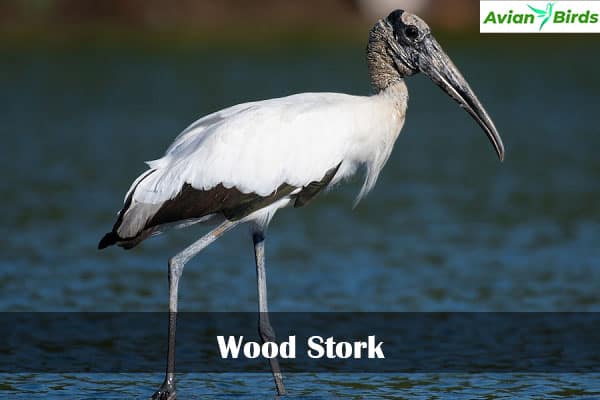
| Attribute | Description |
|---|---|
| Scientific Name | Mycteria americana |
| Habitat | Freshwater swamps, wetlands |
| Diet | Fish, amphibians, invertebrates |
| Size | Around 3 feet tall, 5-foot wingspan |
| Behavior | Feeds by feel, highly sensitive to wetland conditions |
6. Eurasian Spoonbill
The Eurasian Spoonbill (Platalea leucorodia) stands out with its unique, spoon-shaped bill, used to sweep through water for small fish and invertebrates. These birds have pure white plumage and elegant crests in the breeding season and are found in wetlands across Europe and Asia. They are social birds, often seen in groups.

| Attribute | Description |
|---|---|
| Scientific Name | Platalea leucorodia |
| Habitat | Shallow wetlands, marshes |
| Diet | Fish, crustaceans, insects |
| Size | Up to 3 feet tall |
| Behavior | Social, uses bill to forage by touch |
7. Marabou Stork
The Marabou Stork (Leptoptilos crumenifer) is known for its massive size, bald head, and distinctive inflatable throat sac. Found in African savannas, these scavengers play an important role in the ecosystem by consuming carrion. With a wingspan reaching up to 10 feet, they are powerful flyers and often soar high with vultures.

| Attribute | Description |
|---|---|
| Scientific Name | Leptoptilos crumenifer |
| Habitat | African savannas, wetlands |
| Diet | Carrion, small mammals, fish |
| Size | Up to 5 feet tall, 10-foot wingspan |
| Behavior | Scavenger, often seen with vultures |
8. White-faced Ibis
The White-faced Ibis (Plegadis chihi) is a slender bird with iridescent, dark green plumage and a white facial outline. It is commonly found in North and South American wetlands and uses its long, down-curved bill to probe for insects and crustaceans in the mud. Often spotted in flocks, this type of ibis is a social bird known for its stunning colours in the sunlight.
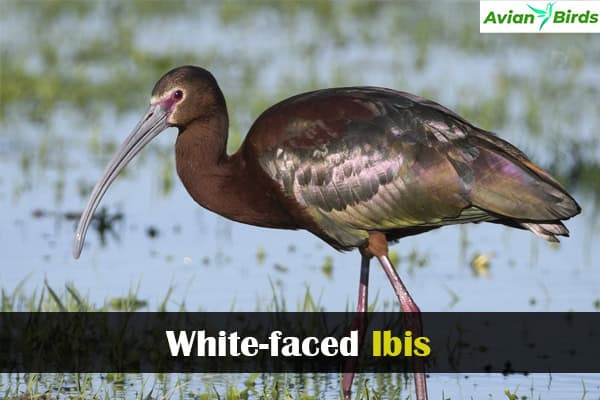
| Attribute | Description |
|---|---|
| Scientific Name | Plegadis chihi |
| Habitat | Wetlands, marshes |
| Diet | Insects, crustaceans, small fish |
| Size | Around 2 feet tall |
| Behavior | Social, forages in flocks, vibrant in sunlight |
9. African Jacana
The African Jacana (Actophilornis africanus), often called the “lily trotter,” is famous for its ability to walk on floating vegetation thanks to its elongated toes. Found in sub-Saharan Africa, this bird has brown and blue plumage and is commonly seen gliding across water lilies in shallow freshwater habitats. Its diet consists primarily of insects and small invertebrates found on plants or the water’s surface.
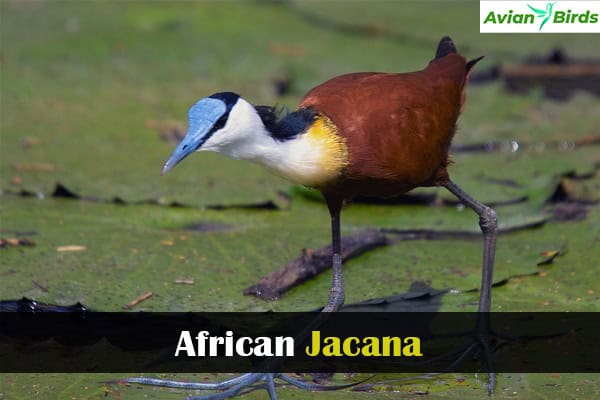
| Attribute | Description |
|---|---|
| Scientific Name | Actophilornis africanus |
| Habitat | Freshwater wetlands, lily-covered lakes |
| Diet | Insects, small invertebrates |
| Size | Around 9 inches tall |
| Behavior | Walks on floating vegetation |
10. Yellow-crowned Night Heron
The Yellow-crowned Night Heron (Nyctanassa violacea) is a medium-sized wading bird with a distinct black-and-white head pattern and long legs. Primarily active during twilight, it is often seen foraging along coastal areas in the Americas. Known for its preference for crustaceans, this heron has a stocky body and powerful beak suited for catching prey. More read for birds of prey.

| Attribute | Description |
|---|---|
| Scientific Name | Nyctanassa violacea |
| Habitat | Coastal areas, mangroves |
| Diet | Crustaceans, insects, small fish |
| Size | Around 2 feet tall |
| Behavior | Nocturnal forager, crustacean specialist |
11. Black-winged Stilt
The Black-winged Stilt (Himantopus himantopus) is an elegant, long-legged shorebird with striking black and white plumage. Found in wetlands across various continents, these stilts forage by wading through shallow water, using their slender bills to catch small aquatic creatures. Known for their agility and social behavior, they are often seen in flocks.
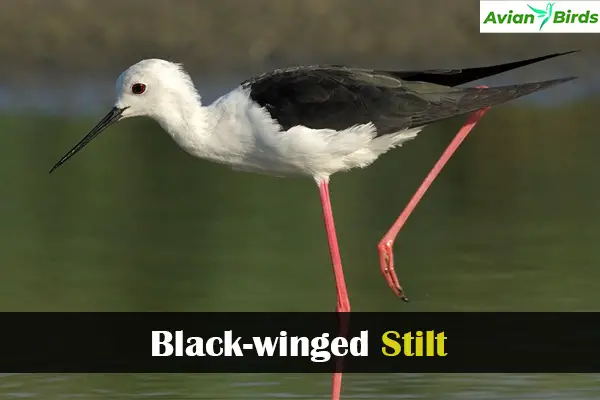
| Attribute | Description |
|---|---|
| Scientific Name | Himantopus himantopus |
| Habitat | Wetlands, salt flats, marshes |
| Diet | Insects, crustaceans, small fish |
| Size | Around 14 inches tall |
| Behavior | Social, forages in groups |
12. Roseate Spoonbill
The Roseate Spoonbill (Platalea ajaja) is a striking wading bird known for its vibrant pink feathers and flat, spoon-shaped bill. Found in marshes and coastal areas of the Americas, this spoonbill uses its specialized bill to sift through water, catching fish and invertebrates. With a unique color and feeding style, it is a popular sight in birdwatching areas.

| Attribute | Description |
|---|---|
| Scientific Name | Platalea ajaja |
| Habitat | Marshes, coastal lagoons |
| Diet | Fish, crustaceans, insects |
| Size | Around 2.5 feet tall |
| Behavior | Filter-feeding with spoon-shaped bill |
13. Scarlet Ibis
The Scarlet Ibis (Eudocimus ruber) is renowned for its vibrant red coloration, which it gains from a diet rich in carotenoids. Native to South American coastal regions, this ibis is a social bird, often seen in flocks. Its slender body and slightly curved bill make it adept at foraging in muddy flats for crabs and other small prey.

| Attribute | Description |
|---|---|
| Scientific Name | Eudocimus ruber |
| Habitat | Coastal areas, mudflats, mangroves |
| Diet | Crabs, crustaceans, insects |
| Size | Around 2 feet tall |
| Behavior | Social, vibrant red due to diet |
14. Australian Pelican
The Australian Pelican (Pelecanus conspicillatus) is easily identified by its enormous bill, one of the largest among birds. Known for its black-and-white plumage and coastal habitat, this pelican is a skilled fisher, often scooping up fish in its large pouch. Found across Australia and surrounding islands, it’s a common sight near water bodies.
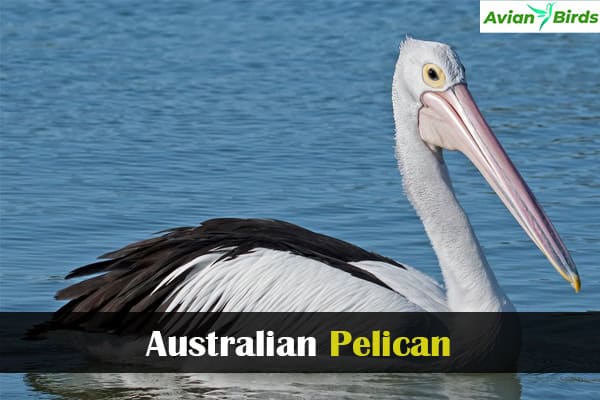
| Attribute | Description |
|---|---|
| Scientific Name | Pelecanus conspicillatus |
| Habitat | Coastal areas, rivers, lakes |
| Diet | Fish, occasionally amphibians |
| Size | Up to 5 feet tall |
| Behavior | Uses bill pouch to scoop fish |
15. Reddish Egret
The Reddish Egret (Egretta rufescens) is notable for its reddish-brown neck and active foraging style. Found along North and Central American coasts, this egret chases fish through shallow waters in a display of agility. Its distinctive foraging dance and its elegant appearance make it a fascinating bird to watch.
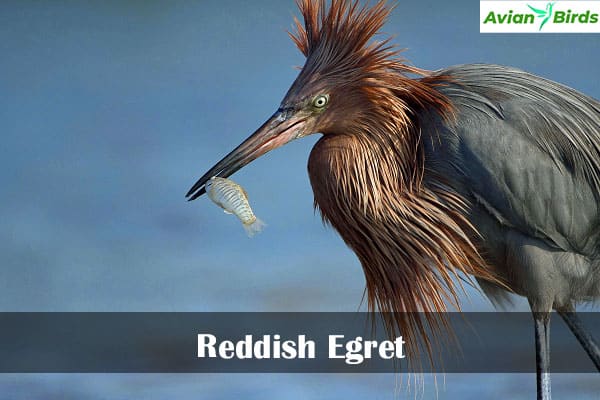
| Attribute | Description |
|---|---|
| Scientific Name | Egretta rufescens |
| Habitat | Coastal lagoons, tidal flats |
| Diet | Fish, small aquatic creatures |
| Size | Around 2.5 feet tall |
| Behavior | Active forager, known for “dancing” |
16. Purple Heron
The Purple Heron (Ardea purpurea) is a striking bird with a slender body, chestnut-brown plumage, and distinctive dark streaks along its neck. Common in European and Asian wetlands, this heron is a stealthy hunter, patiently stalking fish, frogs, and insects in shallow water. Known for its cryptic behavior, it blends well into reeds and dense vegetation.
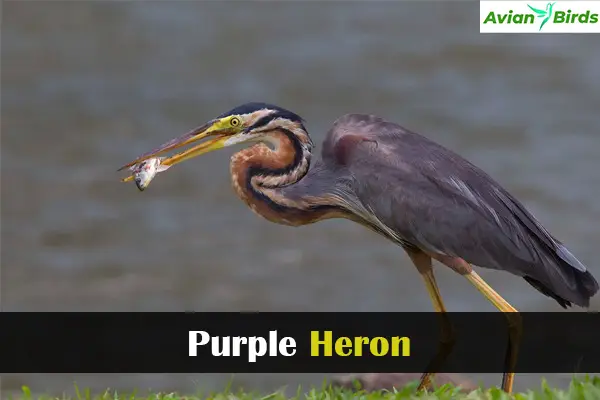
| Attribute | Description |
|---|---|
| Scientific Name | Ardea purpurea |
| Habitat | Wetlands, reed beds |
| Diet | Fish, frogs, insects |
| Size | About 3 feet tall |
| Behavior | Stealthy, skilled at camouflage |
17. Red-legged Seriema
The Red-legged Seriema (Cariama cristata) is a terrestrial bird with long legs and an elegant stance, native to South America. Recognized by its unique reddish legs and crest, it uses its speed to capture prey such as insects and small mammals. With a loud, barking call, it is often seen foraging on the ground in open savannas.
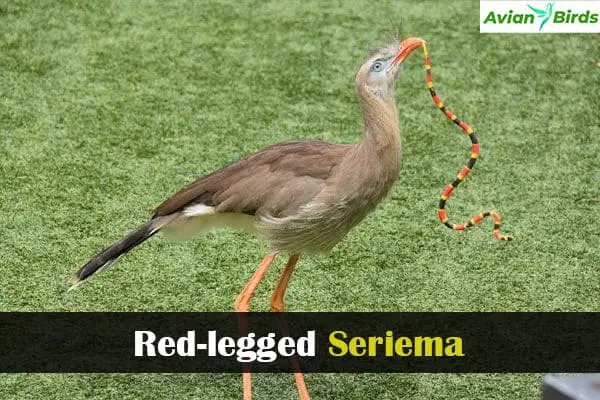
| Attribute | Description |
|---|---|
| Scientific Name | Cariama cristata |
| Habitat | Grasslands, savannas |
| Diet | Insects, small mammals |
| Size | Around 3 feet tall |
| Behavior | Terrestrial, fast runner |
18. African Openbill
The African Openbill (Anastomus lamelligerus) is easily identified by its specialized bill, which has a gap even when closed. This unique adaptation helps it extract snails from their shells, making it a skilled forager in African wetlands. Known for its dark, glossy plumage, it’s often seen wading in shallow water.
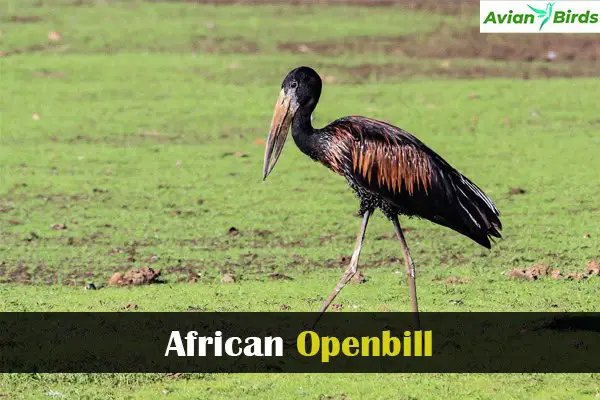
| Attribute | Description |
|---|---|
| Scientific Name | Anastomus lamelligerus |
| Habitat | Wetlands, marshes |
| Diet | Snails, mollusks |
| Size | Around 2.5 feet tall |
| Behavior | Forages in water, snail specialist |
19. American Avocet
The American Avocet (Recurvirostra americana) is a distinctive wader with a slender, upturned bill and striking black-and-white wings. Found in North American wetlands, this bird forages by sweeping its bill side-to-side in shallow water. Known for its elegant appearance, it is often seen in flocks during migration.
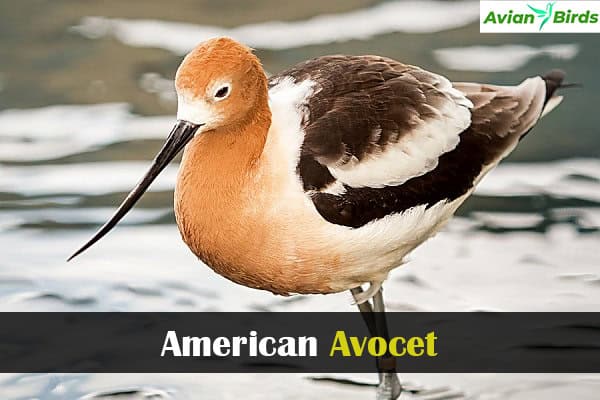
| Attribute | Description |
|---|---|
| Scientific Name | Recurvirostra americana |
| Habitat | Wetlands, salt flats |
| Diet | Small fish, crustaceans, insects |
| Size | Around 18 inches tall |
| Behavior | Social, uses bill to forage by touch |
20. Greater Flamingo
The Greater Flamingo (Phoenicopterus roseus) is famous for its pink coloration, long neck, and thin, stilt-like legs. Found in warm, saline wetlands across Africa, Europe, and Asia, these birds filter-feed on algae and invertebrates. Known for their synchronized displays, they are highly social and often seen in large, colorful flocks.

| Attribute | Description |
|---|---|
| Scientific Name | Phoenicopterus roseus |
| Habitat | Saline lagoons, mudflats |
| Diet | Algae, crustaceans, small invertebrates |
| Size | Around 4 feet tall |
| Behavior | Social, known for group displays |
21. Wattled Crane
The Wattled Crane (Bugeranus carunculatus) is a majestic bird with long legs, a tall stature, and distinctive wattles under its beak. Native to African wetlands, this crane is known for its elaborate mating dances and loud calls. With a preference for undisturbed habitats, it’s a conservation-sensitive species, requiring large wetlands to thrive.
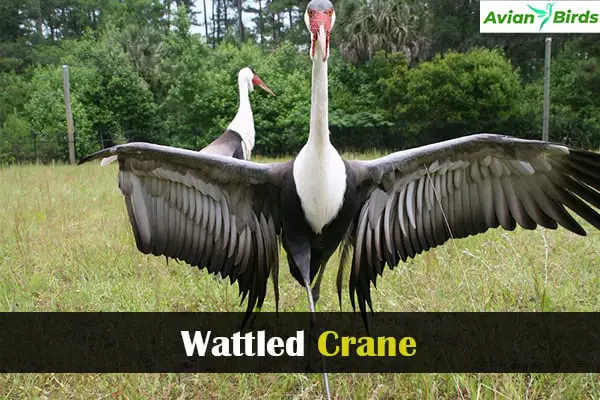
| Attribute | Description |
|---|---|
| Scientific Name | Bugeranus carunculatus |
| Habitat | Wetlands, marshes |
| Diet | Aquatic plants, small invertebrates |
| Size | Around 5 feet tall |
| Behavior | Mating dances, sensitive to disturbance |
22. Glossy Ibis
The Glossy Ibis (Plegadis falcinellus) is a slender wader with iridescent plumage that shimmers with green and bronze hues. Found in wetlands worldwide, this ibis uses its long, curved bill to probe the mud for food. Social by nature, it’s often seen foraging in flocks and adds a touch of color to marshy habitats.
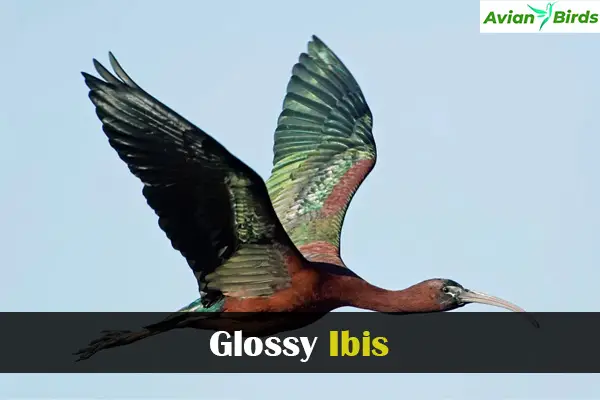
| Attribute | Description |
|---|---|
| Scientific Name | Plegadis falcinellus |
| Habitat | Marshes, swamps |
| Diet | Insects, crustaceans, small fish |
| Size | Around 2 feet tall |
| Behavior | Social, often seen in flocks |
23. White Stork
The White Stork (Ciconia ciconia) is well-known for its iconic appearance, with white plumage and contrasting black wingtips. Native to Europe, Asia, and Africa, this migratory bird often nests near human settlements and feeds on a variety of small animals. Symbolic in folklore, it’s famously known for delivering “good news” or babies.
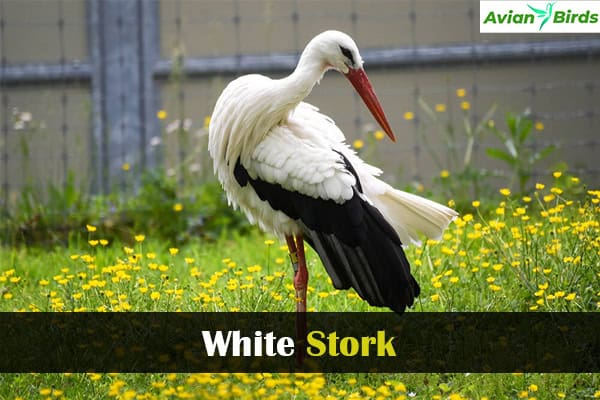
| Attribute | Description |
|---|---|
| Scientific Name | Ciconia ciconia |
| Habitat | Grasslands, wetlands, urban areas |
| Diet | Insects, small mammals, reptiles |
| Size | Around 3.5 feet tall |
| Behavior | Migratory, nests near humans |
24. Saddle-billed Stork
The Saddle-billed Stork (Ephippiorhynchus senegalensis) is a striking bird with a large, colorful bill that resembles a saddle. Native to sub-Saharan Africa, it inhabits wetland areas where it hunts fish and amphibians. With its tall stature and distinctive black-and-white plumage, it’s one of the tallest stork species.

| Attribute | Description |
|---|---|
| Scientific Name | Ephippiorhynchus senegalensis |
| Habitat | Wetlands, riversides |
| Diet | Fish, amphibians, small mammals |
| Size | Up to 5 feet tall |
| Behavior | Solitary, skilled hunter |
25. Sandhill Crane
The Sandhill Crane (Grus canadensis) is a large bird known for its tall, long-legged frame and gray plumage. These cranes are typically found in North America and are famous for their complex courtship dances and loud, trumpeting calls. They prefer wetlands, where they forage for roots, seeds, and insects.

| Attribute | Description |
|---|---|
| Scientific Name | Grus canadensis |
| Habitat | Wetlands, grasslands |
| Diet | Seeds, insects, roots |
| Size | Around 4 feet tall |
| Behavior | Migratory, known for courtship dances |
26. Eurasian Spoonbill
The Eurasian Spoonbill (Platalea leucorodia) is easily identified by its large, spoon-shaped bill. Native to Europe and Asia, this bird is typically found in wetlands where it wades through shallow water in search of small fish, crustaceans, and invertebrates. Its striking white plumage and long legs make it stand out.

| Attribute | Description |
|---|---|
| Scientific Name | Platalea leucorodia |
| Habitat | Wetlands, coastal marshes |
| Diet | Fish, crustaceans, invertebrates |
| Size | Around 3 feet tall |
| Behavior | Wades in shallow water, uses bill for foraging |
27. Greater Yellowlegs
The Greater Yellowlegs (Tringa melanoleuca) is a large shorebird with long, yellow legs and a slender body. Found throughout North America, it is typically seen in coastal mudflats and shallow waters where it forages for small fish and invertebrates. It is known for its loud call and swift, darting movements while hunting.
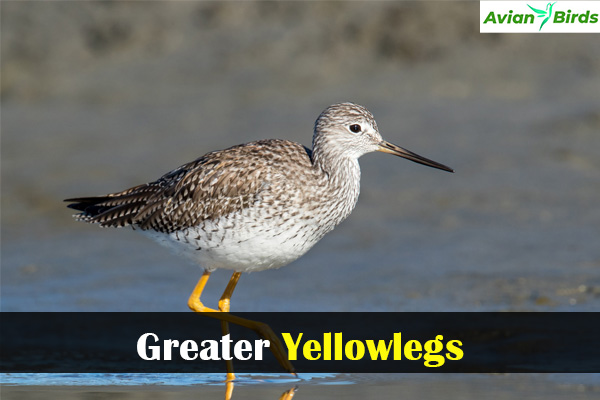
| Attribute | Description |
|---|---|
| Scientific Name | Tringa melanoleuca |
| Habitat | Mudflats, coastal wetlands |
| Diet | Small fish, invertebrates |
| Size | Around 14 inches tall |
| Behavior | Fast, active forager |
28. Little Egret
The Little Egret (Egretta garzetta) is a small, graceful wader with pristine white plumage and long, slender legs. It is commonly found in Europe, Africa, and Asia, and is known for its elegant foraging behavior. The Little Egret hunts by slowly stalking through shallow water, using its sharp bill to capture fish and amphibians.

| Attribute | Description |
|---|---|
| Scientific Name | Egretta garzetta |
| Habitat | Wetlands, coastal habitats |
| Diet | Fish, amphibians |
| Size | Around 2 feet tall |
| Behavior | Slow, deliberate forager |
29. Striated Heron
The Striated Heron (Butorides striata) is a small heron with a compact body and long, thin legs. It is known for its secretive behaviour and is often found along shorelines in mangroves and wetlands. The Striated Heron uses its long bill to capture fish, insects, and small amphibians while blending into its environment.
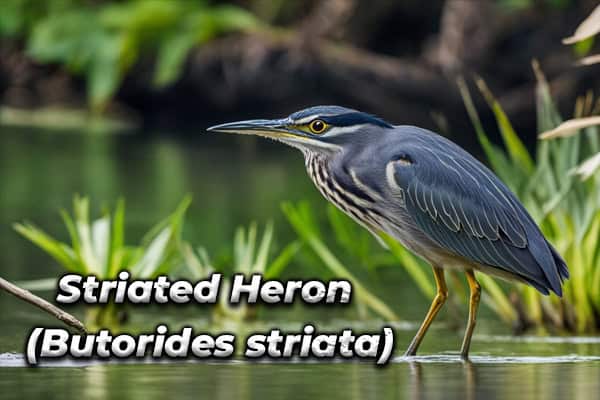
| Attribute | Description |
|---|---|
| Scientific Name | Butorides striata |
| Habitat | Mangroves, wetlands |
| Diet | Fish, insects, small amphibians |
| Size | Around 1.5 feet tall |
| Behavior | Secretive, camouflaged forager |
30. Sacred Ibis
The Sacred Ibis (Threskiornis aethiopicus) is a medium-sized wader with striking black and white plumage and long, slender legs. Native to Africa, this bird is often seen in wetlands and grasslands where it feeds on a variety of insects, small fish, and amphibians. It is also known for its association with ancient Egyptian mythology.
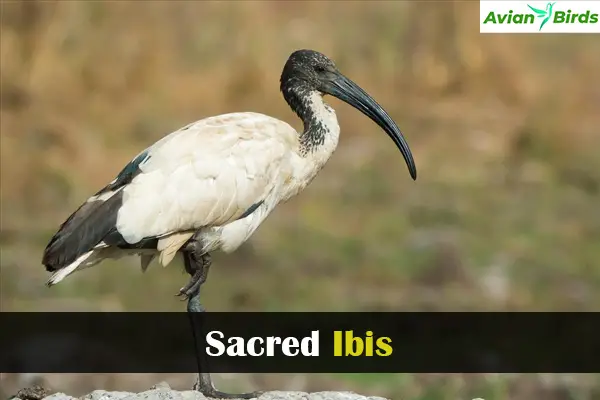
| Attribute | Description |
|---|---|
| Scientific Name | Threskiornis aethiopicus |
| Habitat | Wetlands, grasslands |
| Diet | Insects, small fish, amphibians |
| Size | Around 3 feet tall |
| Behavior | Social, often seen in groups |
FAQ’s About Birds with Long Legs
Q1. What are the different types of long-legged birds?
Long-legged birds include herons, cranes, flamingos, storks, and egrets. They are commonly found in wetlands and other watery habitats.
Q2. Why do some birds have long legs?
Long legs help these birds wade through water and mud while keeping their bodies dry, and they assist in spotting prey from a distance.
Q3. How do long-legged birds hunt for food?
Many use a “stand and wait” technique to catch fish or insects, while others wade through shallow water to hunt small animals.
Q4. Which long-legged birds are found in wetlands?
Common wetland species include herons, egrets, cranes, and flamingos, as well as some types of storks.
Q5. Are herons and cranes the same?
No, herons and cranes differ in body structure and behavior. Herons tend to have a more curved neck and hunt individually, while cranes are social and have a straighter neck.
Q6. What do long-legged birds eat?
They typically eat fish, insects, amphibians, and small crustaceans. Some, like cranes, also eat grains and seeds.
Q7. Why do wading birds have long legs?
Their long legs allow them to wade into deeper water than other birds, giving them access to more food sources and protection from some predators.
Q8. What are the biggest long-legged birds?
The tallest is the sarus crane, which can reach up to 6 feet tall. The great blue heron is also a large species among long-legged birds.
Q9. How to identify a long-legged bird?
Look for a tall stature, a long neck, and usually a sharp beak suited for fishing. Common habitats include wetlands, rivers, and lakes.
Q10. Which long-legged birds are native to North America?
Native long-legged birds include the great blue heron, sandhill crane, and the American flamingo, primarily in warmer regions.

